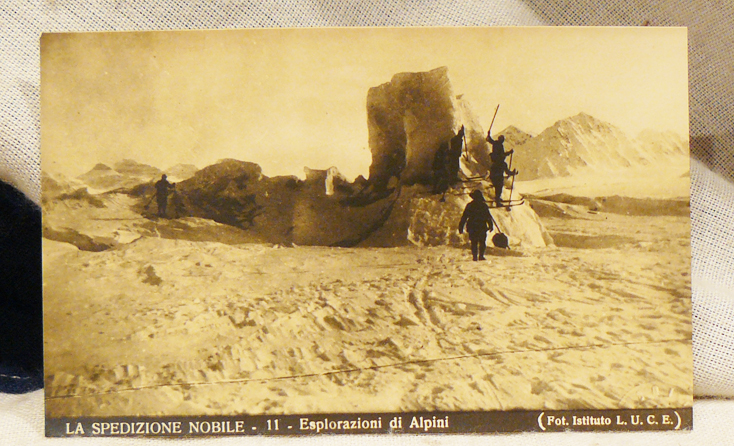A Most Rare Set Of 12 Original Photographs Of The General Nobile 1928 Polar Airship Expedition
Original Polar Expeditions collectables are most highly desirable and we have been delighted to acquire two such connected lots. These are 12 original photographic postcards, published at the time, by two publishers, Traldi and Ballerini & Fratini. For example one is entitled "La Spedizione Nobile - 11 - Esplorazioni di Alpini."
Ed. A. Traldi, Milan, n.d. c. 1928. and another "General Nobile to edge of Italy before leaving."
Umberto Nobile January 21, 1885 ? July 30, 1978) was an Italian aeronautical engineer and Arctic explorer. Nobile was a developer and promoter of semi-rigid airships during the Golden Age of Aviation between the two World Wars. He is primarily remembered for designing and piloting the airship Norge, which may have been the first aircraft to reach the North Pole, and which was indisputably the first to fly across the polar ice cap from Europe to America. Nobile also designed and flew the Italia, a second polar airship; this second expedition ended in a deadly crash and provoked an international rescue effort.The N-class airship Italia was slowly completed and equipped for Polar flight during 1927-28. Part of the difficulty was in raising private funding to cover the costs of the expedition, which finally was financed by the city of Milan; the Italian government limited its direct participation to providing the airship and sending the aging steamer Citt? di Milano as a support vessel to Svalbard, under the command of Giuseppe Romagna.
This time the airship used a German hangar at Stolp en route to Svalbard and the mast at Vads? (Northern Norway). On May 23, 1928, after an outstanding 69 hour long flight to the Siberian group of Arctic islands, the Italia commenced its flight to the North Pole with Nobile as both pilot and expedition leader. On May 24, the ship reached the Pole and had already turned back toward Svalbard when it ran into a storm. On May 25, the Italia crashed onto the pack ice less than 30 kilometres north of Nordaustlandet (Eastern part of Svalbard). Of the 16 men in the crew, ten were thrown onto the ice as the gondola was smashed; the remaining six crewmen were trapped in the buoyant superstructure as it ascended skyward due to loss of the gondola; the fate of the six men was never resolved. One of the ten men on the ice, Pomella, died from the impact; Nobile suffered a broken arm, broken leg, broken rib and head injury; Cecioni suffered two badly broken legs; Malmgren suffered a severe shoulder injury and suspected injury to a kidney; and Zappi had several broken ribs.
The crew managed to salvage several items from the crashed airship gondola, including a radio transceiver, a tent which they later painted red for maximum visibility, and, critically, packages of food and survival equipment which quick-witted engineer Ettore Arduino had managed to throw onto the ice before he and his five companions were carried off to their deaths by the wrecked but still airborne airship envelope and keel. As the days passed, the drifting sea ice took the survivors towards Foyn and Broch islands.
A few days after the crash the Swedish meteorologist Malmgren and Nobile's second and third in command Mariano and Zappi decided to leave the immobile group and march towards land. Malmgren, who was injured, weakened and reportedly still depressed over his meteorological advice that he felt contributed to the crash, asked his two Italian companions to continue without him. These two were picked up several weeks later by the Soviet icebreaker "Krasin". However there were persistent rumors that Malmgren was killed and cannibalized by Zappi and Mariano
They would look incredible suitably bespoke framed [with UV protected glass]
Code: 18032
675.00 GBP







